Inner and outer retinal pathways both contribute to surround inhibition of salamander ganglion cells
- PMID: 15760938
- PMCID: PMC1464530
- DOI: 10.1113/jphysiol.2005.083436
Inner and outer retinal pathways both contribute to surround inhibition of salamander ganglion cells
Abstract
Illumination of the receptive-field surround reduces the sensitivity of a retinal ganglion cell to centre illumination. The steady, antagonistic receptive-field surround of retinal ganglion cells is classically attributed to the signalling of horizontal cells in the outer plexiform layer (OPL). However, amacrine cell signalling in the inner plexiform layer (IPL) also contributes to the steady receptive-field surround of the ganglion cell. We examined the contributions of these two forms of presynaptic lateral inhibition to ganglion cell light sensitivity by measuring the effects of surround illumination on EPSCs evoked by centre illumination. GABA(C) receptor antagonists reduced inhibition attributed to dim surround illumination, suggesting that this inhibition was mediated by signalling to bipolar cell axon terminals. Brighter surround illumination further reduced the light sensitivity of the ganglion cell. The bright surround effects on the EPSCs were insensitive to GABA receptor blockers. Perturbing outer retinal signalling with either carbenoxolone or cobalt blocked the effects of the bright surround illumination, but not the effects of dim surround illumination. We found that the light sensitivities of presynaptic, inhibitory pathways in the IPL and OPL were different. GABA(C) receptor blockers reduced dim surround inhibition, suggesting it was mediated in the IPL. By contrast, carbenoxolone and cobalt reduced bright surround, suggesting it was mediated by horizontal cells in the OPL. Direct amacrine cell input to ganglion cells, mediated by GABA(A) receptors, comprised another surround pathway that was most effectively activated by bright illumination. Our results suggest that surround activation of lateral pathways in the IPL and OPL differently modulate the sensitivity of the ganglion cell to centre illumination.
Figures

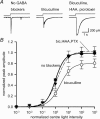
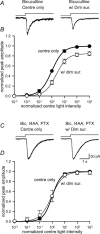
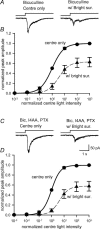

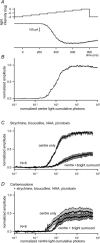
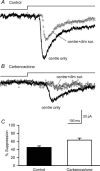

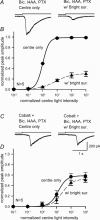
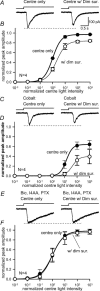

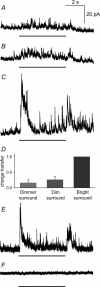
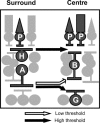
Similar articles
-
Spike-dependent GABA inputs to bipolar cell axon terminals contribute to lateral inhibition of retinal ganglion cells.J Neurophysiol. 2003 May;89(5):2449-58. doi: 10.1152/jn.00916.2002. Epub 2002 Nov 13. J Neurophysiol. 2003. PMID: 12611993
-
GABA transporters regulate inhibition in the retina by limiting GABA(C) receptor activation.J Neurosci. 2002 Apr 15;22(8):3285-92. doi: 10.1523/JNEUROSCI.22-08-03285.2002. J Neurosci. 2002. PMID: 11943830 Free PMC article.
-
Synaptic currents generating the inhibitory surround of ganglion cells in the mammalian retina.J Neurosci. 2001 Jul 1;21(13):4852-63. doi: 10.1523/JNEUROSCI.21-13-04852.2001. J Neurosci. 2001. PMID: 11425912 Free PMC article.
-
Synaptic mechanisms that shape visual signaling at the inner retina.Prog Brain Res. 2005;147:205-18. doi: 10.1016/S0079-6123(04)47016-2. Prog Brain Res. 2005. PMID: 15581708 Review.
-
GABAC receptor-mediated inhibition in the retina.Vision Res. 2004 Dec;44(28):3289-96. doi: 10.1016/j.visres.2004.07.023. Vision Res. 2004. PMID: 15535996 Review.
Cited by
-
Comparison of ring 1 parameters in 37-segment multifocal electroretinography between onset and offset conditions of ring 2 to 4 in normal subjects.Int J Ophthalmol. 2019 Jan 18;12(1):73-78. doi: 10.18240/ijo.2019.01.11. eCollection 2019. Int J Ophthalmol. 2019. PMID: 30662843 Free PMC article.
-
Spatiotemporal characteristics of retinal response to network-mediated photovoltaic stimulation.J Neurophysiol. 2018 Feb 1;119(2):389-400. doi: 10.1152/jn.00872.2016. Epub 2017 Oct 18. J Neurophysiol. 2018. PMID: 29046428 Free PMC article.
-
Light adaptation alters inner retinal inhibition to shape OFF retinal pathway signaling.J Neurophysiol. 2016 Jun 1;115(6):2761-78. doi: 10.1152/jn.00948.2015. Epub 2016 Feb 24. J Neurophysiol. 2016. PMID: 26912599 Free PMC article.
-
General features of inhibition in the inner retina.J Physiol. 2017 Aug 15;595(16):5507-5515. doi: 10.1113/JP273648. Epub 2017 May 4. J Physiol. 2017. PMID: 28332227 Free PMC article. Review.
-
Dopamine D1 receptor activation contributes to light-adapted changes in retinal inhibition to rod bipolar cells.J Neurophysiol. 2018 Aug 1;120(2):867-879. doi: 10.1152/jn.00855.2017. Epub 2018 May 30. J Neurophysiol. 2018. PMID: 29847232 Free PMC article.
References
-
- Cook PB, McReynolds JS. Lateral inhibition in the inner retina is important for spatial tuning of ganglion cells. Nat Neurosci. 1998a;1:714–719. - PubMed
-
- Cook PB, McReynolds JS. Modulation of sustained and transient lateral inhibitory mechanisms in the mudpuppy retina during light adaptation. J Neurophysiol. 1998b;79:197–204. - PubMed
-
- Cook PB, McReynolds JS, Lukasiewicz PD. Action potentials are necessary for wide-field inhibitory signals in the inner plexiform layer of amphibian retina. Invest Ophthalmol Vis Sci. 1996;37:S1153.
Publication types
MeSH terms
Substances
Grants and funding
LinkOut - more resources
Full Text Sources

